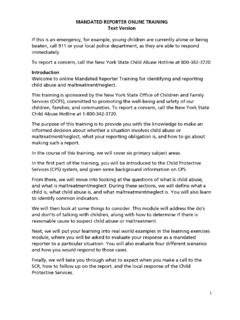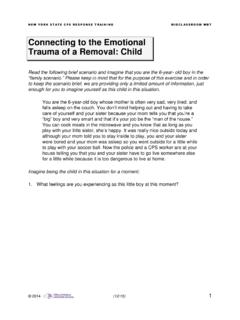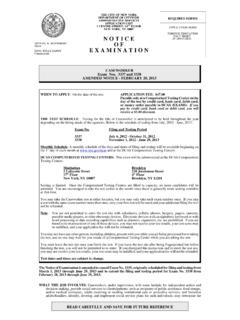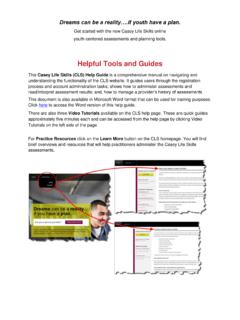Transcription of Critical Thinking Skills for Child Welfare Caseworkers
1 N E W Y O R K S T A T E C P S RE S P O N S E T R A I N I N G P R E C L A S S R O O M W B T 2014 (12/15) 1 Applying Critical Thinking Skills within the casework process supports the achievement of the Child Welfare outcomes by promoting an open-mindedness to gathering new or more accurate information, a willingness to make or revise decisions that reflect these refined analyses, and a method for evaluating the actions taken by Caseworkers and family members. Example: A caseworker who applies Critical Thinking Skills won t assume that all the case information he/she inherited when assigned a case is the last word on the family s situation.
2 He/she will weigh the information in the case record against his/her own observations and may decide he/she needs to re-interview a parent, Child , or a source to gather more data about a trend he/she has detected in the family. There is no simple, predictable formula for applying Critical Thinking Skills , so it isn t something you can do in a linear fashion. Be aware that you will often need to go back and reuse Skills in order to gain the information you need to support accurate assessments. Listed below are Critical Thinking Skills that are used in Child Welfare . Organize the initial information and separate what appear to be facts from what appear to be judgments/assumptions.
3 Example: As a preventive worker is about to arrive for an initial home visit, a neighbor tells her that the family s grade-school children walk a long way to school in the winter without proper clothing. Upon receipt of this initial information, the worker recognizes that the words proper clothing and a long way are judgments that require clarification and the words grade-school children and school are statements of fact that can be verified. Recognize the likelihood of bias in your personal opinions, acknowledge the intensity of your feelings about them, and be aware of the danger of weighing case evidence in the decision-making process according to your personal standards.
4 Example: A foster care worker whose father was an alcoholic realizes that she may be biased in assessing the influence of alcohol on a parent s abilities and seeks supervision to promote informed and objective decision-making related to her case. Temporarily suspend judgment in the absence of sufficient evidence. Example: After reviewing information that a Child in foster care has been injured, the worker reminds herself not to assume that the foster parents or siblings were responsible for the injuries the Child may have suffered until further information is gathered. Develop as many reasonable explanations ( , multiple hypotheses) as you can to explain or account for indicators of abuse/maltreatment.
5 Critical Thinking Skills for Child Welfare Caseworkers N E W Y O R K S T A T E C P S RE S P O N S E T R A I N I N G P R E C L A S S R O O M W B T 2014 (12/15) 2 Example: A CPS worker receives a report that alleges educational neglect of a 13-year-old who is missing school about half of the time. The worker developed two hypotheses regarding this information: 1) the Child could be cutting classes after the bus drops her off at school (and the parents are unaware of this); and 2) the Child could have a chronic illness and the parents failed to inform the school and make alternate arrangements for her education.
6 After consulting with her supervisor, she added two more hypotheses: 3) the Child could be truant because the parents are requiring her to care for their younger children; and 4) she could be kept at home because her parents are trying to hide injuries that may have resulted from abuse or maltreatment. Examine and follow up on insufficient information, gaps in information, or inconsistencies in information being gathered. Example: A teenager recently placed in an adoptive family has run away from the home following a fight with one of the other children in the home, according to the parents. The teen returned to the adoptive home of his own accord within hours.
7 The father called the worker to let her know that the teen was safe at home. The worker immediately scheduled a home visit. During the interview with the family, the father and mother gave somewhat inconsistent information about the alleged fight that occurred between the teen and other Child in the home that prompted the teen to run away. The teen disclosed he ran away following an argument with the father. The worker confronted the parents and teen regarding the inconsistencies in their explanations. Recognize the limitations in your knowledge and experience and draw upon available resources as necessary to strengthen the quality of your casework practice.
8 Example: A worker who has no experience working with cases involving domestic violence sought consultation from his supervisor related to how to develop a safety plan with the mother and children in his case. Look for patterns that appear during the case, rather than only examining the singular facts. Example: A case has just been transferred to preventive services. After reviewing the family s prior history with her agency, the worker saw a pattern emerge related to the mother s mental health status and when requests for services were made. She then reevaluated her perspective and current thoughts about the case.
9 Question your own assessments and consider all associated case implications. Example: An adoption worker met with her supervisor to review a home study and realized that she hadn t yet assessed the mental and physical status of the aunt who the parents said will supervise the Child they want to adopt when they re at work. The worker mentioned this to her supervisor and together they identified the information that is still needed, as well as sources the worker will need to consult in order to get it. Critical Thinking Skills for Child Welfare Caseworkers









